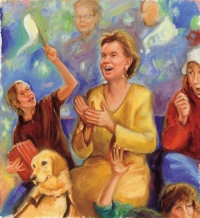Hospital hound
July 14, 2010 • 17 Comments • Posted in blindness, UncategorizedNote: Mike usually looks my blog posts over before I hit the publish button, but for reasons I am about to explain he is not available today. Please forgive weird formatting or distorted photos…
First, the most important news. Mike came through his gall bladder surgery today just fine. He’s at home now, resting in the next room.
As for Hanni and me, we’re fine, too! the staff at Northwestern Hospital treated us beautifully. That is, they treated us like everyone else who was there waiting for their loved ones to get out of surgery.
. Hanni knows a lot of commands. “Follow” was particularly handy today. “Hanni, follow!” The patient care technician led us into the room where Mike was waiting for anesthesia. “Hanni, follow!” The receptionist led us to her phone. The recovery room nurse was on the line. She wanted to let me know that Mike was, well, recovering. , “Hanni, follow!” The patient care tech came out again to tell me Mike had finally woken up. We followed as we were led to Mike’s room and sat there with Mike until he was discharged.
Nurse after nurse after nurse entered Mikes room then, each wanting a glimpse of Hanni. “Ohhhhh!” they’d gush. “She’s beautiful!” Hanni responded the way she always does when she gets attention. She wagged her tail. Poor Mike. He goes through the trouble of having surgery and still Hanni gets all the attention. But Mike didn’t mind. He was glad we both were there. I was glad we were there, too. It felt right.
Poor Mike. He goes through the trouble of having surgery and still Hanni gets all the attention. But Mike didn’t mind. He was glad we both were there. I was glad we were there, too. It felt right.
only one staff member questioned Mike about whether or not someone was coming later to pick him up. “Oh, my wife’s here,” he said, pointing my way. Mike described how the woman had looked at me, and then at Hanni, and then again at Mike.
“We’re taking a cab home,”
He reassured her.
“a cab,” she said with a nervous laugh. “That’s a good thing!”
When it was time to go, Hanni and I kept pace with the patient care technician as he pushed Mike in a wheelchair towards the hospital lobby. “Hanni, follow!” I repeated over and over, turning right, left, right, right and left again until we were finally outside hailing a taxi.
Mike broke the rules in the back of the cab. He pet Hanni all the way home, even though she had her harness on. I didn’t scold either of them. After all, this was a special occasion.


